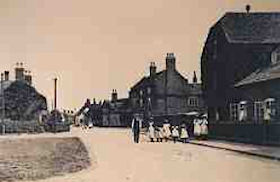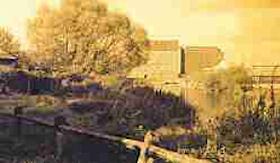Amber House
18 Burton Road
Alrewas |
Accommodation - Bed & Breakfast, short stays |
|
|
|---|
|
|
|
| |
History of Alrewas
A Short History of Alrewas
 |
|---|
Main Street, Early 1900s
|
Alrewas is one of the oldest recorded communities in the Midlands. Salt, a widely needed commodity of the primeval races, was carried by trader's ponies from the salt springs and mines of Cheshire to London. One such track passed through Alrewas, coming from the north west via Kings Bromley, through Orgreave, along Overley Lane and through Alrewas to cross the ford of Trent either at Mill End or the weir, forking south to cross the Tame Ford near the present Salters' Bridge and continuing south-east. It is possible that the salt traders (and others) might at times be held up at the fords by flooding, and this could have been the reason why an Iron-age farm became a village, to supply the needs of the trading people.
After the Roman and Danish invaders left the great Saxon, Leofric, Earl of Mercia, held the Manor and lived at Kings Bromley. Alrewas is mentioned in many ancient records as Aldersways. There was a church there in 822 and after the Norman Conquest the Manor belonged to the crown until the reign of King John. In 1349 the people suffered from the Black Death and two thirds of the villagers died.
 |
|---|
The Mill 1960 (now Cotton Close)
|
In 1643 there is a record of a fire which began one Sunday morning in the village alehouse kept by George Thorniwake. One of his customers fired off a 'horne gun' and the alehouse was destroyed along with the barns and horses of his neighbours John Fitchell and John Francis.
In ancient times Alrewas was famous for its eel fishery and basket weaving was a thriving cottage industry, using osiers that grew so plentifully on the banks of the river.
The following account was given of Alrewas in 1968. It had an area of 6,130 acres with a population of 3050: Alrewas has a wide, unspoilt main street with a remarkable number of 16th century houses, their black beams, white walls and thatched roofs are kept in excellent repair. The parish church of All Saints still has many items of interest ranging in date from the 13th to the 17th century. As is the case with many other parishes there are new houses, well designed and pleasantly arranged to fit in with the old village and surrounding countryside. To the north-west of the village are pleasant walks towards Wychnor by the winding River Trent and its tributary the Tame. To the south-west are the lanes leading to the hamlet of Fradley and to Fradley Woods. The A38, the old Roman Road from Lichfield to Burton-on-Trent runs along the West side of Alrewas. The very popular show of the Alrewas & District Agricultural and Horticultural Society is held annually.
A Major Discovery
 |
|---|
Woolly Rhino, 2002
|
In 2002 a major archaeological discovery was unearthed in the sand and gravel quarry at Whitemoor Haye near Alrewas. The chance find was made by Ray Davies, a worker at the Lafarge Aggregates quarry, who pulled up the massive skull of a woolly rhino in the bucket of his digger. Archaeologists from the University of Birmingham were called in to supervise the recovery of the skeleton which dates back to the Ice Age. Gary Coates, a University of Birmingham archaeologist, said, I've been working at Whitemoor Haye Quarry for five years and have excavated everything from prehistoric burial grounds to Roman farmsteads, but this find was totally unexpected. It's the biggest find - in all senses of the word - I've ever been involved with. Initially the rhino remains were taken to the University's archaeological unit for cleaning and identification.
The rhino, believed to have died 30 - 40 thousand years ago and weighing approximately one and a half tonnes, has now been taken to the Natural History Museum in London to be conserved. Andy Currant, a palaeontologist from the Natural History Museum, said, This is the best example of a woolly rhino I have ever seen. The bones are exceptionally well preserved - usually, remains have been scavenged by predators and only fragments survive. The dig has also uncovered the remains of mammoth, reindeer, wild horse and a wolf as well as plants and beetles which provide an extraordinarily detailed picture of the freezing environment in which the rhino lived and died. This important find demonstrates the rich archaeological heritage of this area.
Further Reading
A book of the History of Alrewas was written in 1987 by a resident of the village, Norman Stubbs. Alrewas in the early 1950s features in a book entitled Sutton Coldfield in the Fifties, Part 1: the Early Fifties about a former railwayman's two week relief duties at Alrewas railway station. Brief mentions include Gerald Dollin, John Dickinson's shop, The Tree Café (at that time owned by Tofts but now the British Legion Club), Wychnor Flowers, Haunton Hall Nunnery and Mr Orme. Copies of the book (£12.95) are available from the author Rev John Bassett on 01543 255975.
In 2008 an updated version of The History of Alrewas by Norman Stubbs and Roger Hailwood was published. This is available from the Post Office, Paul's Newsagents in the Main Street or directly from Roger Hailwood (Tel. 01283-790188) at a cost of £10 + £1.25 p&p.
|
|
|
|
|
|
Top of Page
Last updated:
May 21st, 2012
|
Gill Jones |
|---|
Amber House, 18 Burton Road, Alrewas, Staffs, DE13 7BB, England
Tel: Mobile: 07812 202415
Published by: Lichfield Web Design
|
|